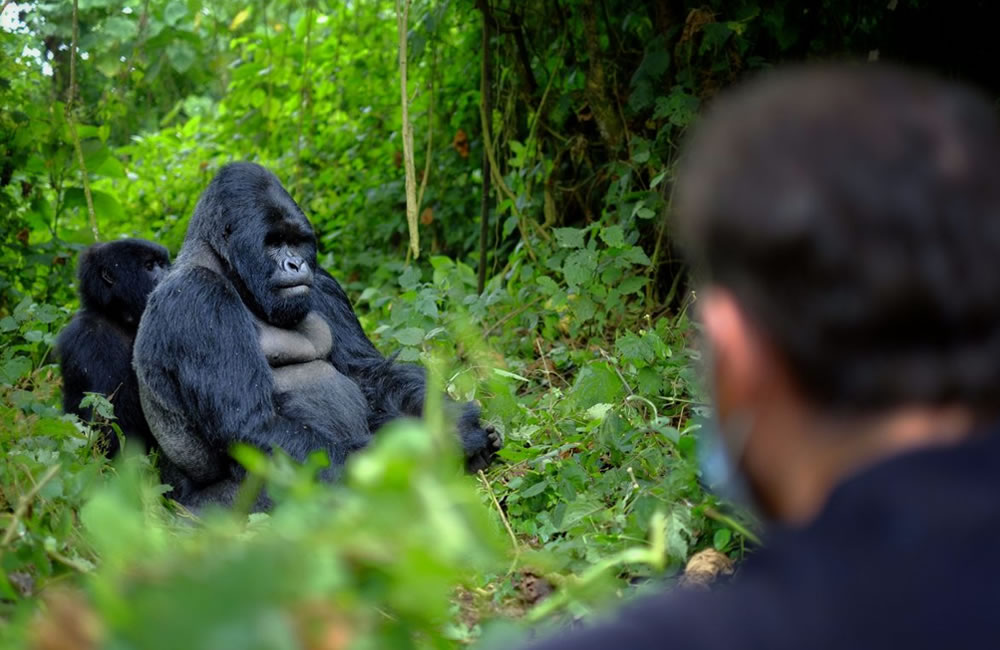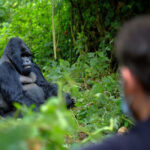Gorilla trekking in Uganda is one of the best wildlife experiences in Africa. There are stringent safety precautions in place, and the field guides who accompany you on the treks are total professionals who know more about the gorillas and their behavior than anyone on the planet.
Gorilla trekking is a safe enterprise, so long as you follow a few basic rules and listen to your trek guide. We introduce you to the safety guidelines for gorilla trekking to give you peace of mind about this extraordinary adventure.
Moreover, the troops that folks visit on gorilla treks are habituated, which means they’re used to being around humans.
There are of course some fairly commonsensical rules that you should obey on a gorilla trek to ensure your safety as well as the well-being of the gorillas. And your gorilla trek guide is the person to look to if you’re ever uncertain about what to do (or not do). He or she is there to protect you and knows the visited troop well.
Mountain gorillas are gentle giants
Some might understandably have qualms about the mountain gorillas themselves. A silverback can weigh around 150 to 180 kg, after all. But while mountain gorillas are extremely powerful especially the fully grown males, they’re quite gentle by nature.
Mountain gorillas are even vegetarians and predominantly, at least – sometimes they eat insects. So, while gorillas will defend themselves if attacked, they’re not aggressive creatures. And they have no interest in messing with humans.
You visit habituated gorillas
Further enhancing everyone’s safety is the fact that the gorilla troops you visit on a trek are habituated. This means they’ve undergone a long process of slowly becoming accustomed to the presence of humans. They’re therefore less likely to become alarmed and agitated by your presence.
You trek with a trained guide
When you go on a gorilla trek you go in the company of a trained guide. Such men and women know the gorilla troops being visited, and know what can and cannot be done.
It is important to always listen to your ranger and stay with the group while trekking. Listen to what you’re told to do and not do. Poking a silverback’s stomach, for instance, is not allowed. But if you follow the rules of your trek guide and act with common sense, you’re perfectly safe visiting the gorillas.
The age limit for Gorilla Tracking
The age limit for gorilla trekking in Volcanoes National Park in Rwanda is 15 years and above. This is the age limit for all tourists planning a gorilla safari in Rwanda. Age verification using your official identification documents like national IDs and passports will be done. The age limit was put at 15 because all those that are 15 and above can easily be controlled, unlike children below the age who are hard to control and might be forced to run in case a gorilla approaches them. They make noise and play around.
Gorilla Trekking Safety Guidelines
Obviously, there are rules to follow when observing the gorillas that are geared towards not angering, frightening or in any other way upsetting the gorillas. Here are some simple guidelines to follow when in the presence of mountain gorillas to further ensure everything goes smooth.
The forest trek is safe, but tough
Mountain gorillas live in montane forest, which means you have to walk along forest trails to find them. A gorilla trek is all about seeing these magnificent animals in their natural habitat, after all.
Every forest trek varies in length and difficulty depending on a few factors, like which park your visit, the weather, and the particular gorilla troop you’ve been assigned (troops’ locations are monitored by park rangers and each trek group is assigned a specific troop to visit).
Generally speaking, visitors can ask to be assigned a troop near or far from the starting point. The less fit, for example, may wish to have shorter hike. Hikes range from about half an hour to three or four hours. There are no overnight hikes.
You need to be prepared
Probably the biggest ‘danger’ on a gorilla trek is to do with navigating the mountainous and forested terrain. You often walk along narrow or even non-existent trails.
Further, note that the route you walk is likely to be steep in places, as well as muddy and slippery. So, you want hiking boots with good grip. And you might also consider bringing along trekking poles or a walking stick, as many others do.
You can also hire the services of a porter, who not only carries your backpack for you but also helps you to navigate tricky sections.
Finally, it can be really cold in the early morning, as well as hot at midday when the there’s no cloud cover. So, you need to be prepared for all kinds of weather, having warm layers, a waterproof shell, and sunscreen and a sunhat.
Uganda and Rwanda are stable countries
We regularly travel in both Rwanda and Uganda, the two main countries where visitors head to go gorilla trekking. And we’re pleased to say that Rwanda and Uganda are relatively stable countries with thriving tourism industries. The locals in both countries are warm and welcoming towards visitors.
Well-run national parks
Moreover, the parks where the mountain gorillas live – Bwindi Impenetrable National Park in Uganda and Volcanoes National Park in Rwanda – are particularly well maintained and patrolled.
Visitor safety is a top priority at both parks, and experienced trek guides always accompany every gorilla trekking party. So, you’re in one of the safest spots of each country when you go gorilla trekking. You can also see mountain gorillas in the DRC, but we don’t recommend that as a destination right now.
We also recommend travelling with a local tour guide to further ensure your safety. No matter where you go in the world, having a local look after you is always a great idea, as they know the culture, environment, people and wildlife of the place.
In conclusion
Although safety measures have been put in place, you also need to ensure that you take care of your personal Security to contribute to safety during a gorilla trek safari in Uganda and Rwanda.
Follow all the rules and regulations that were put in place because they are to protect you from mountain gorilla attacks and protect the gorillas from extinction.


